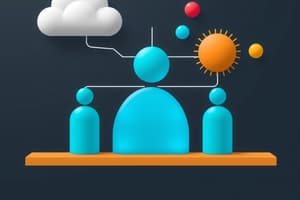Podcast
Questions and Answers
What is the primary goal of Organizational Development (OD) models for change?
What is the primary goal of Organizational Development (OD) models for change?
The primary goal of OD models for change is to enhance organizational effectiveness and facilitate planned change processes.
How does the Pugh OD matrix assist in the change management process?
How does the Pugh OD matrix assist in the change management process?
The Pugh OD matrix helps in evaluating and comparing different change options based on criteria, aiding decision-making.
Explain the significance of a 'rich picture' in the context of organizational change.
Explain the significance of a 'rich picture' in the context of organizational change.
'Rich pictures' are visual representations that illustrate complex organizational issues and relationships, facilitating understanding and communication.
What are the basic assumptions underlying Organizational Development models?
What are the basic assumptions underlying Organizational Development models?
Describe a responsibility chart's role in change management.
Describe a responsibility chart's role in change management.
In the context of soft systems models, why is stakeholder involvement crucial?
In the context of soft systems models, why is stakeholder involvement crucial?
What are soft systems models, and how do they differ from harder models in managing change?
What are soft systems models, and how do they differ from harder models in managing change?
What role does communication play in implementing an OD model?
What role does communication play in implementing an OD model?
Study Notes
Organizational Change: Strategies for Managing Change
- Organizational Development (OD) provides frameworks for facilitating change within organizations.
- Soft systems models are critical in addressing complex, real-world issues by promoting adaptive learning and participation among stakeholders.
Key Models and Concepts in OD
- OD Model for Change: Based on fundamental assumptions that every organization must adapt to survive and that humans are key agents of change.
- The model emphasizes collaboration, feedback, and continuous learning processes essential for effective change management.
Visual Tools and Representations
- Rich Picture: A visual tool illustrating the current state and interconnections in service changes for individuals with learning disabilities, enabling understanding of complex situations.
- Responsibility Chart: A diagram that outlines roles and responsibilities within a team or organization to ensure accountability during the change process.
- Pugh OD Matrix: A decision-making tool used to assess multiple options against a set of criteria to determine the best approach to change.
Practical Applications
- Emphasizes the importance of involving all stakeholders in the change process to enhance buy-in and reduce resistance.
- Highlights the necessity for clear communication and ongoing support during transitions to achieve desired outcomes.
Summary of Change Management Strategies
- Organizations should adopt a holistic view, addressing the interconnectedness of people, processes, and systems.
- Change initiatives should be continually assessed and adjusted based on feedback and results to ensure long-term sustainability.
Studying That Suits You
Use AI to generate personalized quizzes and flashcards to suit your learning preferences.
Related Documents
Description
Test your knowledge on Chapter 8 of Organizational Change, which focuses on soft systems models for managing change. This quiz will explore key concepts and strategies essential for effective organizational development. Dive into the principles and practices that facilitate successful change within organizations.




